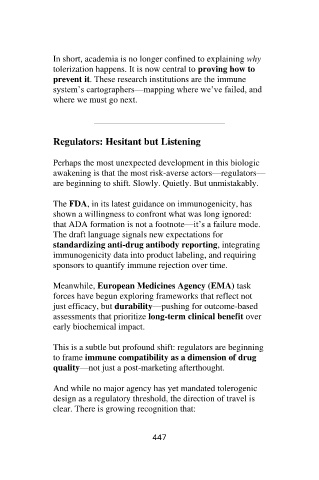Page 449 - Binder2
P. 449
In short, academia is no longer confined to explaining why
tolerization happens. It is now central to proving how to
prevent it. These research institutions are the immune
system’s cartographers—mapping where we’ve failed, and
where we must go next.
Regulators: Hesitant but Listening
Perhaps the most unexpected development in this biologic
awakening is that the most risk-averse actors—regulators—
are beginning to shift. Slowly. Quietly. But unmistakably.
The FDA, in its latest guidance on immunogenicity, has
shown a willingness to confront what was long ignored:
that ADA formation is not a footnote—it’s a failure mode.
The draft language signals new expectations for
standardizing anti-drug antibody reporting, integrating
immunogenicity data into product labeling, and requiring
sponsors to quantify immune rejection over time.
Meanwhile, European Medicines Agency (EMA) task
forces have begun exploring frameworks that reflect not
just efficacy, but durability—pushing for outcome-based
assessments that prioritize long-term clinical benefit over
early biochemical impact.
This is a subtle but profound shift: regulators are beginning
to frame immune compatibility as a dimension of drug
quality—not just a post-marketing afterthought.
And while no major agency has yet mandated tolerogenic
design as a regulatory threshold, the direction of travel is
clear. There is growing recognition that:
447

